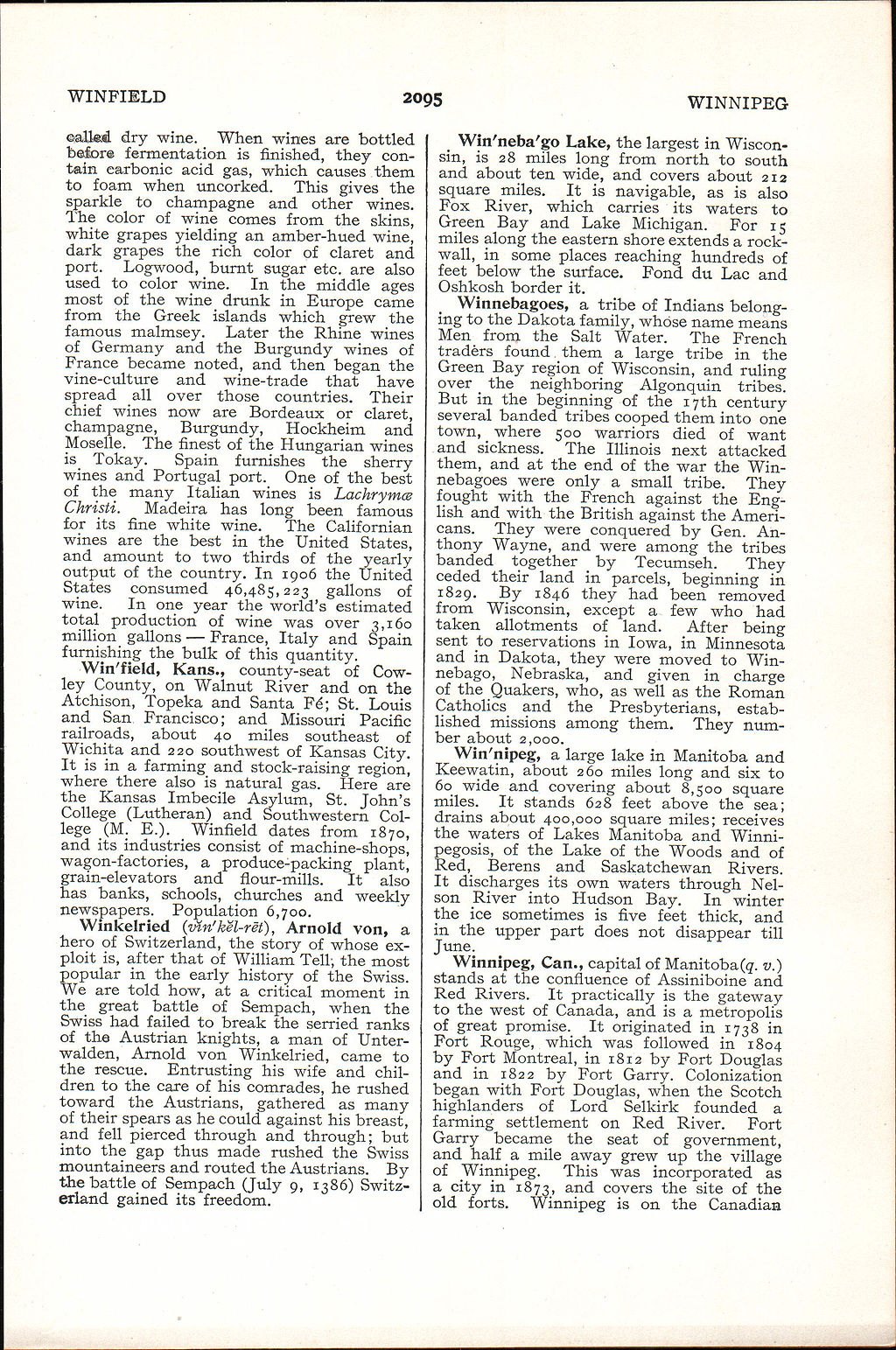WINPIELD
2095
WINNIPEG
©alkii dry wine. When wines are bottled b@Jbr® fermentation is finished, they contain carbonic acid gas, which causes them to foam when uncorked. This gives the sparkle to champagne and other wines. The color of wine comes from the skins, white grapes yielding an amber-hued wine, dark grapes the rich color of claret and port. Logwood, burnt sugar etc. are also used to color wine. In the middle ages most of the wine drunk in Europe came from the Greek islands which grew the famous malmsey. Later the Rhine wines of Germany and the Burgundy wines of France became noted, and then began the vine-culture and wine-trade that have spread all over those countries. Their chief wines now are Bordeaux or claret, champagne, Burgundy, Hockheim and Moselle. The finest of the Hungarian wines is Tokay. Spain furnishes the sherry wines and Portugal port. One of the best of the many Italian wines is Lachrymas Christi. Madeira has long been famous for its fine white wine. The Californian wines are the best in the United States, and amount to two thirds of the yearly output of the country. In 1906 the United States consumed 46,485,223 gallons of wine. In one year the world's estimated total production of wine was over 3,160 million gallons — France, Italy and Spain furnishing the bulk of this quantity.
Win'field, Kans., county-seat of Cow-ley County, on Walnut River and on the Atchison, Topeka and Santa Fe*; St. Louis and San Francisco; and Missouri Pacific railroads, about 40 miles southeast of Wichita and 220 southwest of Kansas City. It is in a farming and stock-raising region, where there also is natural gas. Here are the Kansas Imbecile Asylum, St. John's College (Lutheran) and Southwestern College (M. E.). Winfield dates from 1870, and its industries consist of machine-shops, wagon-factories, a produce-packing plant, grain-elevators and flour-mills. It also has banks, schools, churches and weekly newspapers. Population 6,700.
Winkelried (v%nfkel-ret), Arnold von, a hero of Switzerland, the story of whose exploit is, after that of William Tell, the most popular in the early history of the Swiss. We are told how, at a critical moment in the great battle of Sempach, when the Swiss had failed to break the serried ranks of the Austrian knights, a man of Unter-walden, Arnold von Winkelried, came to the rescue. Entrusting his wife and children to the care of his comrades, he rushed toward the Austrians, gathered as many of their spears as he could against his breast, and fell pierced through and through; but into the gap thus made rushed the Swiss mountaineers and routed the Austrians. By the battle of Sempach (July 9, 1386) Switzerland gained its freedom.
Win'neba'go Lake, the largest in Wisconsin, is 28 miles long from north to south and about ten wide, and covers about 212 square miles. It is navigable, as is also Fox River, which carries its waters to Green Bay and Lake Michigan. For 15 miles along the eastern shore extends a rock-wall, in some places reaching hundreds of feet below the surface. Fond du Lac and Oshkosh border it.
Winnebagoes, a tribe of Indians belonging to the Dakota family, whose name means Men from the Salt Water. The French traders found. them a large tribe in the Green Bay region of Wisconsin, and ruling over the neighboring Algonquin tribes. But in the beginning of the i7th century several banded tribes cooped them into one town, where 500 warriors died of want and sickness. The Illinois next attacked them, and at the end of the war the Winnebagoes were only a small tribe. They fought with the French against the English and with the British against the Americans. They were conquered by Gen. Anthony Wayne, and were among the tribes banded together by Tecumseh. They ceded their land in parcels, beginning in 1829. By 1846 they had been removed from Wisconsin, except a few who had taken allotments of land. After being sent to reservations in Iowa, in Minnesota and in Dakota, they were moved to Win-nebago, Nebraska, and given in charge of the Quakers, who, as well as the Roman Catholics and the Presbyterians, established missions among them. They number about 2,000.
Win'nipeg, a large lake in Manitoba and Keewatin, about 260 miles long and six to 60 wide and covering about 8,500 square miles. It stands 628 feet above the sea; drains about 400,000 square miles; receives the waters of Lakes Manitoba and Winni-pegosis, of the Lake of the Woods and of Red, Berens and Saskatchewan Rivers. It discharges its own waters through Nelson River into Hudson Bay. In winter the ice sometimes is five feet thick, and in the upper part does not disappear till June.
Winnipeg, Can., capital of Manitoba(q. v.) stands at the confluence of Assiniboine and Red Rivers. It practically is the gateway to the west of Canada, and is a metropolis of great promise. It originated in 1738 in Fort Rouge, which was followed in 1804 by Fort Montreal, in 1812 by Fort Douglas and in 1822 by Fort Garry. Colonization began with Fort Douglas, when the Scotch highlanders of Lord Selkirk founded a farming settlement on Red River. Fort Garry became the seat of government, and half a mile away grew up the village of Winnipeg. This was incorporated as a city in 1873, an(^ covers the site of the old forts. Winnipeg is on the Canadian
